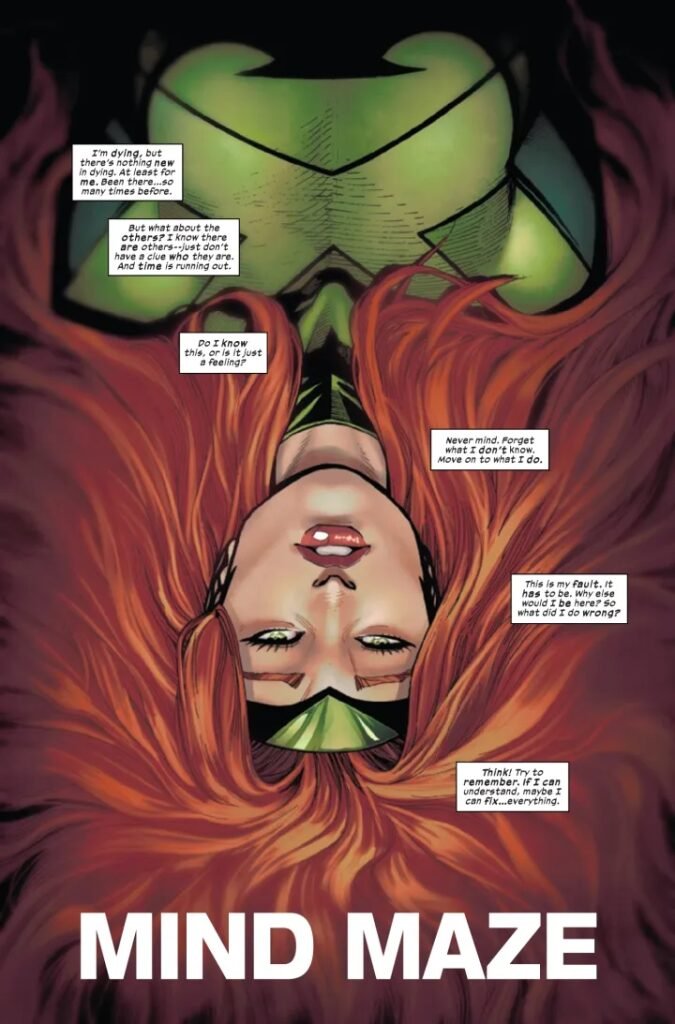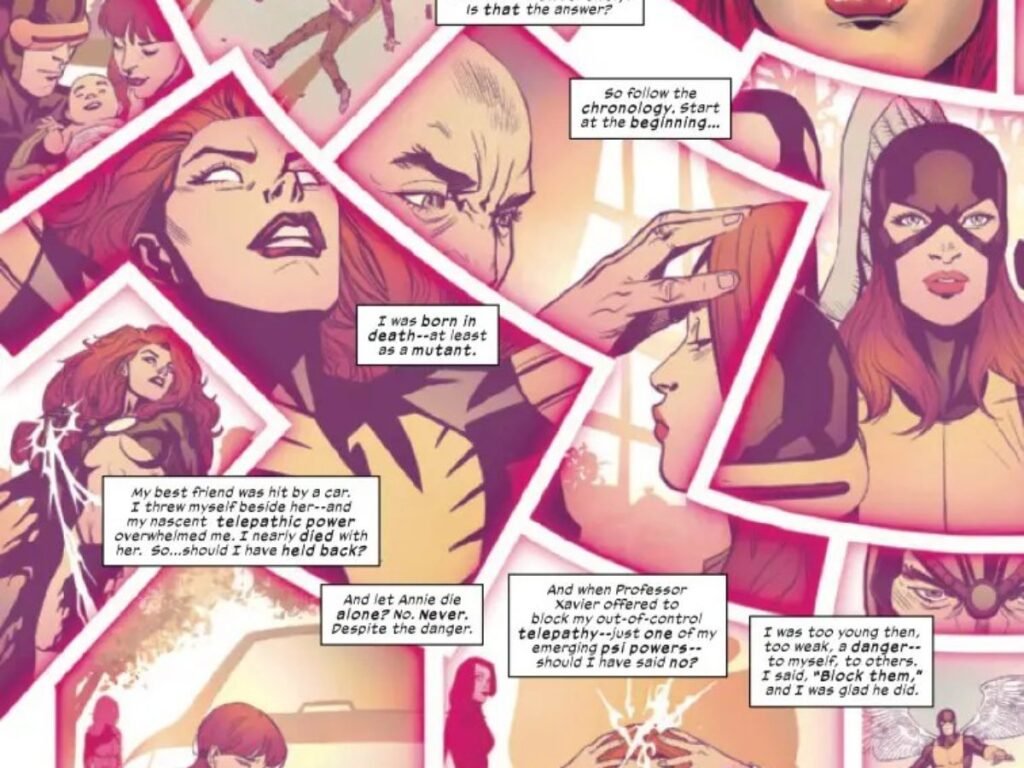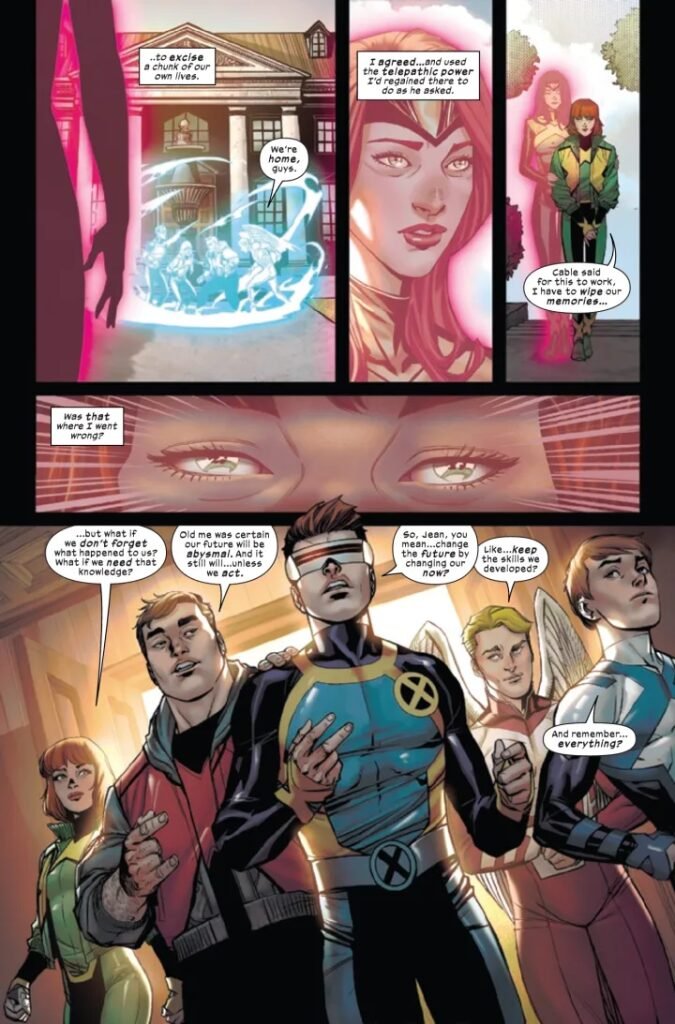Writer: Louise Simonson
Art: Bernard Chang
Marvel Comics, 2023
Jean Grey is dead, again, and she is not particularly surprised about it. The long-standing character, a charter member of Marvel Comics’ headline mutant title Uncanny X-Men and its numerous spawn, is probably the record holder for death and revival even within the eulogy-friendly genre of superhero comics.

Lyng on the floor in the opening pages of this freshly released first issue of this new title, Jean Grey #1, Jean’s life flashes before her eyes. But her life is displayed in literal shards, significant memories scattered across a double-page spread.



(The panel is very reminiscent of this 1993 Uncanny X-Men promotional poster.)
Writer Louise Simonson chooses to use Jean Grey’s imminent death as a means of exploring an alternative reality. Marvel Comics for decades has intermittently published a title called What If…? The concept was recently retooled as a popular animated series referencing characters and storylines from Marvel Studio’s motion pictures. For Marvel Comics, the title has been a mechanism to explore the options which its characters might have taken: “What if Wolverine had killed the Hulk?” and “What If Aunt May Had Been Bitten by that Radioactive Spider?” Jean Grey is a What If…? story.
Jean wonders what if she had not wiped the memories of herself and her fellow teammates at the conclusion of an extended time-travel caper in which they met their future selves. This epic was set out in All New X-Men, a series which ran from 2013 to 2016. What if Jean had not erased those experiences, and instead the young team gained the benefit of not just newfound skills, but also knowledge of the future?

For reasons we question below, the story is explored through the dying mind of Jean Grey. This younger version of Jean Grey is much more out of kilter with the utopian pacifism of their mentor, the telepathic Charles Xavier. During what would have been an early encounter of the original X-Men with Magneto, Jean has no qualms in eviscerating his mind with her psychic powers. Xavier is unimpressed and ejects the X-Men from his school. From there, Jean’s moral compass gets increasingly erratic until, finally, Xavier sends a team of X-Men (including a wheelchair bound Magneto) to hunt her.
That goes extremely badly, and perhaps inevitably, we all walk back along the ash-strewn road to Phoenix. (We have discussed Phoenix at length before: see Phoenix and the Three Thors: The Mighty Thor #19-21 (Review) – World Comic Book Review .) Marvel Comics knows that Phoenix sells comic books, one of the reasons why they commissioned the very striking cover to this issue.

Sometime ago in order to demonstrate that Jean Grey did not have an inherently voracious creature bottled up instead her cortex, the Phoenix was recast by Marvel Comics as the Phoenix Force. The Phoenix Force can possess anyone and grant them cosmic powers replete with bird imagery. (Even the dour mutant leader Cyclops got a Phoenix make-over at one point.) It was in our view a regrettably mistake to parse Jean Grey from Phoenix. Although Jean Grey is labelled by Marvel Comics as an “omega level” mutant (a mutant whose powers are planet-threatening) the carving out of Phoenix from Jean Grey reduced both characters. Cosmic threats tend to be male within the American superhero genre: Darkseid, Thanos, Trigon, Krona, the Beyonder, Galactus, Mephisto, Dormammu, and Annihilus are a men’s locker-room of conquerors and world-devourers. (and many of them look alike for good reason – see Separated at Birth: the beetle-browed villains of American comic books – World Comic Book Review ). Thor’s adversary Hela cuts a lonely sight amongst the fellas. (DC Comics has no female cosmic threats – Chris Claremont’s Maitresse from his 1996 series Sovereign Seven is long forgotten.) Jean Grey has not just been repeatedly killed, but was also stripped of the status of being the exclusive host of a universe-threatening villain. And the Phoenix Force is now just a very cantankerous power battery for anyone capable of harnessing it.
What was the point of this story? As a What If…? fable, the concept of considering what if the young X-Men retaining their memories is not a bad one. But this story is plainly shoehorned into Marvel’s latest X-Men epic, Fall of X, and does not seem to have anything to do with the balance of the story. The X-Men have been crushed by the evil anti-mutant organisation Orchis. Charles Xavier initially believed he banished most of the world’s mutants to a terraformed Mars, but it evolves 250000 mutants have instead just disappeared. The mutant hunting AI named Nimrod has mushed Iceman, and then pulped the villain Juggernaut. Jean Grey herself has just been stabbed in the chest and spends her last moments communicating with Firestar and with her two lovers, Cyclops and Wolverine. Amidst all of this excitement, why bother with a What If…? What if this story had been told within the pages of a What If…? comic? This is instead akin to watching a rooster wear socks.

